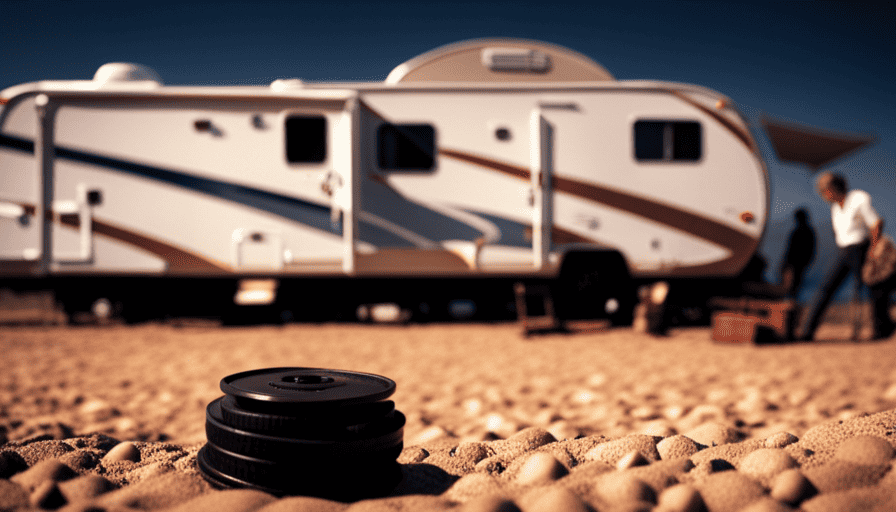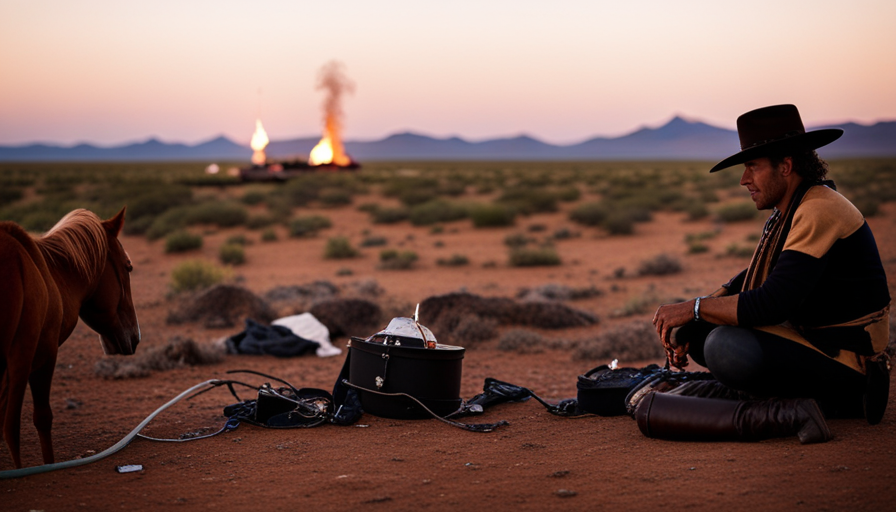Have you ever wondered, “What is the point of using blocks to support a camper?”
Well, picture this: you’re out on a camping adventure, ready to unwind and relax in your cozy camper. But wait, the camper is tilting to one side, making you feel like you’re constantly walking on a slope. Not the most enjoyable experience, right?
That’s where leveling your camper on blocks comes into play.
In this article, I will guide you through the precise and technical process of leveling a camper on blocks. By following these steps, you’ll ensure a stable and comfortable camping experience. Leveling a camper trailer on blocks can be a straightforward process if done correctly. First, you’ll need to gather the necessary equipment, such as leveling blocks, a level, and wheel chocks. Then, you’ll need to carefully position the blocks and drive the camper onto them, ensuring that it is level side-to-side and front-to-back. Finally, use the level to double-check the camper’s position and make any adjustments as needed. With these steps, you’ll be able to enjoy your camping trip without any worries about an unsteady camper.
We’ll assess your camper’s leveling needs, gather the necessary tools and materials, and choose the right type of blocks. Then, we’ll position your camper on a level surface and begin the leveling process, starting from side to side.
We’ll check the level of your camper, secure the blocks in place, and test the stability. And of course, we’ll make any necessary adjustments along the way.
So, let’s dive in and ensure your camper is level and ready for your next adventure!
Key Takeaways
- Leveling a camper on blocks is essential for a stable and comfortable camping experience.
- Assess the leveling needs of your camper by measuring the slope using a bubble level or smartphone app.
- Choose the right type of blocks for leveling needs, such as interlocking blocks, wooden blocks, or leveling ramps.
- Ensure the blocks are positioned correctly and securely, and regularly inspect them to maintain stability.
Assess the Leveling Needs of Your Camper
Before you start your camping adventure, it’s crucial to assess the leveling needs of your camper. This involves determining the stability of your camper when parked on uneven ground. Assessing the leveling needs is important because an unlevel camper can cause discomfort, affect appliance functionality, and pose safety risks.
To assess the leveling needs, start by parking your camper on a flat surface and observe if it leans to one side or if the tires are off the ground. Use a bubble level or smartphone app to measure the slope in different areas of the camper. This will help you determine how much leveling is needed and which side requires more attention.
Once you have assessed the leveling needs, you can gather the necessary tools and materials. This may include leveling blocks, wooden planks, or even a leveling system specifically designed for campers. By having the appropriate tools on hand, you can ensure that you have everything you need to level your camper effectively and efficiently.
With the assessment complete and the necessary tools gathered, you’re ready to move on to the next step of leveling your camper on blocks.
Gather the Necessary Tools and Materials
First off, you’ll need to grab a measuring tape to ensure you have the right amount of space between the ground and your RV. This step is crucial as it determines the level of your camper and prevents any potential damage. Understanding the importance of camper leveling is key to a safe and comfortable camping experience.
To gather the necessary tools and materials, here’s a list to help you get started:
-
Measuring tape: This’ll allow you to accurately measure the distance between the ground and your camper, ensuring proper leveling.
-
Blocks: These’re essential for raising the low side of your camper and achieving a level position.
-
Level: A bubble level or an RV leveling system can be used to determine if your camper is level or not.
-
Chocks: These’re wedges that can be placed on the tires to prevent any movement while leveling your camper.
Choosing the right tools is essential to ensure a successful leveling process. Once you’ve gathered these tools, you can move on to the next step of choosing the right type of blocks for your camper’s leveling needs.
Choose the Right Type of Blocks
To achieve a stable and balanced position for your RV, it’s important to select the perfect type of blocks for your leveling needs. Choosing the right type of blocks can make a significant difference in how well your camper sits on the ground. There are several options available, each with their own pros and cons.
One popular choice is interlocking leveling blocks. These blocks are made of a durable material, such as high-density polyethylene, and can be stacked together to achieve the desired height. They’re lightweight and easy to store, making them a convenient option. However, interlocking blocks may not provide as much stability as other types, especially on soft or uneven surfaces.
Another option is wooden leveling blocks. These blocks are typically made of pressure-treated lumber and can be easily cut to the desired size. They offer good stability and can be used on a variety of surfaces. However, wooden blocks may be heavier and bulkier to carry and store compared to other options.
Lastly, there are leveling ramps, which are similar to interlocking blocks but have a ramp design. These ramps provide a gradual incline for your camper, making it easier to drive onto them. They’re especially useful for larger RVs or trailers. However, they may not be as versatile as other types of blocks and can be more expensive.
When choosing the right type of blocks, consider factors such as the size and weight of your camper, the type of surface you’ll be parking on, and your personal preferences. Once you’ve selected the appropriate blocks, you can proceed to position your camper on a level surface by following the next steps.
Position Your Camper on a Level Surface
Find a flat and stable area where you can park your RV and ensure that it’s perfectly balanced and stable. When positioning your camper on blocks, it’s crucial to check the ground stability beforehand. Uneven terrain can pose challenges, but with a few tips, you can find a level surface for your camper.
First, examine the area for any slopes or dips. These can affect the stability of your camper and make leveling difficult. Look for a spot that’s as level as possible to avoid any issues later on.
If you’re in an uneven terrain, consider using leveling blocks or ramps to create a stable surface. These can be placed strategically under the tires or jacks to level your camper. Make sure to follow the manufacturer’s instructions when using these blocks or ramps.
Another option is to use a carpenter’s level to check the levelness of the ground. Place the level in different areas of the proposed parking spot to ensure it’s level. This will give you peace of mind knowing that your camper will be stable and balanced.
Finding a level surface for your camper is crucial to ensure its stability and balance. By checking the ground stability and using leveling blocks or ramps, you can position your camper securely. With the level surface established, you can now move on to leveling your camper side to side.
Start by Leveling Side to Side
Begin by ensuring that your RV is positioned on a stable and balanced surface, allowing for easy leveling side to side. Side to side leveling techniques are essential to create a comfortable and stable living environment inside your camper.
To achieve this, start by using a leveling tool, such as a bubble level or a smartphone app, to determine which side of the camper needs to be raised or lowered. Once you have identified the uneven side, you can begin the leveling process.
The most common method is to use leveling blocks placed under the tires on the side that needs to be elevated. These blocks can be purchased at most RV supply stores or you can make your own using pressure-treated lumber. Carefully drive the RV onto the blocks, making sure they are securely in place.
It is important to note that leveling side to side is crucial because it ensures your camper is stable and prevents any potential damage to the interior components. A level surface is essential for proper functioning of appliances, such as the refrigerator, and for preventing any discomfort while sleeping or walking inside the camper.
Now that your camper is level side to side, it is time to move on to the next step: using blocks to raise or lower the camper as needed.
Use Blocks to Raise or Lower the Camper as Needed
Now it’s time to adjust the height of your RV using handy blocks, ensuring a comfortable and stable living space inside.
To raise or lower your camper, you’ll need a set of leveling blocks. These blocks are designed to provide a sturdy foundation and prevent your camper from rocking or shifting.
Using blocks is a simple and effective method for leveling your camper. Start by placing the blocks under the wheels or jacks that need adjustment. If you need to raise the camper, stack the blocks evenly underneath the wheels or jacks until you reach the desired height. On the other hand, if you need to lower the camper, carefully remove blocks one by one until you achieve the desired level. Leveling a camper trailer is an important step to ensure stability and comfort during your camping trip. It’s crucial to take the time to properly level your camper to avoid any issues such as appliances not working correctly or potential damage to the camper itself. Once you have adjusted the blocks and achieved the desired level, double check that everything is secure and stable before fully setting up your camper for your trip.
When using blocks, it’s important to ensure they are positioned correctly and securely. Always double-check that the blocks are aligned with the wheels or jacks, and that they are stacked evenly to provide stability.
Alternatively, you can also use jacks instead of blocks for leveling your camper. Jacks offer more precise adjustments and are particularly useful if you need to level your camper on uneven terrain. However, be cautious when using jacks, as they can be less stable than blocks and may require additional support.
Now that your camper is properly leveled, it’s time to check the level of your camper to ensure everything is balanced and secure.
Check the Level of Your Camper
Once your camper is properly set up, take a moment to check if everything is balanced and secure. Ensuring that your camper is level is crucial for a comfortable and safe camping experience. To check the level of your camper, you can use a bubble level or a smartphone app specifically designed for this purpose. Place the level on a countertop or floor inside the camper and adjust the blocks until the bubble is centered. Pay attention to both the side-to-side and front-to-back level. It is important to note that common leveling mistakes include relying solely on your judgment or not checking the level after the first adjustment. By using a level, you can avoid these mistakes and ensure that your camper is properly leveled. Once you have checked the level and made any necessary adjustments, you can move on to securing the blocks in place. This will help prevent any movement or shifting of the camper while you are inside.
Secure the Blocks in Place
To really lock those blocks in place, give them a firm and satisfying push after adjusting them. This extra step will ensure that the blocks are snugly secured and won’t shift as you move around inside your camper.
Here are a few tips for preventing blocks from shifting and maintaining their stability:
-
Use a rubber or non-slip mat: Placing a rubber or non-slip mat between the blocks and the ground will create friction and help to keep the blocks in place.
-
Opt for interlocking blocks: Interlocking blocks provide added stability by connecting with each other. This feature prevents individual blocks from moving independently and maintains a solid foundation for your camper.
-
Consider using leveling jacks: Leveling jacks can be placed under the corners of your camper to provide additional stability and prevent any swaying or rocking motion.
-
Regularly inspect the blocks: Check the blocks regularly to ensure they’re still secure and haven’t shifted. If you notice any movement, readjust them immediately to maintain stability.
By following these tips, you can effectively secure the blocks in place and prevent any unwanted shifting.
Now, let’s move on to the next section and test the stability of your camper without compromising safety.
Test the Stability of Your Camper
As I push the blocks into place, I feel the firmness under my feet, knowing that my camper is secure and stable. Ensuring the stability of your camper is crucial to prevent any accidents or damage while you’re on the road or parked at a campsite.
There are several ways to prevent camper instability. Firstly, make sure to choose a solid and level surface to park your camper on. Avoid parking on soft or uneven ground, as this can lead to instability. Additionally, consider using stabilizing jacks or wheel chocks to provide extra support and prevent any rocking or movement.
To test the stability of your camper, walk around inside and outside, paying attention to any signs of instability. Look for any movement or shifting of the blocks, and listen for any creaking or shifting noises. If you notice any signs of instability, it’s important to make adjustments as necessary. This may involve repositioning the blocks or adding additional support under the camper.
By taking these precautions and regularly checking for stability, you can ensure a safe and secure camping experience. Transitioning into the subsequent section, making adjustments as necessary is a crucial step in maintaining the stability of your camper.
Make Adjustments as Necessary
Take a moment to inspect the stability of your home on wheels, ensuring it feels like a sturdy and secure sanctuary. To make adjustments as necessary, here are some adjustment techniques and troubleshooting tips that can help you level your camper on blocks.
-
Check the level: Begin by using a leveling tool to determine which areas of your camper need adjustment. This will give you a clear idea of where to focus your efforts.
-
Adjust the blocks: If your camper is leaning to one side, you can add or remove blocks to level it out. Start by placing additional blocks under the low side and gradually remove blocks from the high side until your camper is level.
-
Use stabilizing jacks: Stabilizing jacks can provide additional support and help level your camper. Place them strategically under the corners or areas that need adjustment, and slowly raise or lower them until your camper feels stable.
Remember, it’s important to take your time and make small adjustments to avoid causing stress on your camper’s frame. By following these adjustment techniques and troubleshooting tips, you’ll be able to level your camper on blocks effectively and enjoy a comfortable and stable living space on the road.
Frequently Asked Questions
How do I assess the weight distribution of my camper?
Assessing the weight distribution of your camper is crucial for maintaining stability and preventing damage during your travels. To ensure an accurate assessment, start by measuring the weight on each tire using a scale. This will help you determine if the weight is evenly distributed or if adjustments need to be made.
Remember, leveling your camper isn’t just about comfort, but also about safety and preserving the integrity of your vehicle.
What are the different types of blocks available for leveling a camper?
When it comes to leveling a camper, there are several different materials available for blocks. Some common options include wood, plastic, and rubber.
Each material has its own pros and cons. Wood blocks are sturdy but can be heavy and prone to rot. Plastic blocks are lightweight and durable, but may not provide as much stability. Rubber blocks offer good grip and are lightweight, but may not be as durable as other materials.
Can I use wood blocks instead of plastic blocks?
Personally, I would definitely recommend using plastic blocks over wood blocks when leveling a camper. Plastic blocks are more durable, lightweight, and weather-resistant compared to wood blocks. They’re also easier to clean and maintain. However, if you’re in a pinch and don’t have access to plastic blocks, wood blocks can be a temporary solution.
Just keep in mind that wood blocks are less stable, can rot over time, and may not provide as much support as plastic blocks.
How do I ensure the blocks stay in place while leveling the camper?
To ensure stability and prevent block slippage while leveling a camper on blocks, there are a few key steps to follow.
Firstly, make sure the ground is level and clear of any debris.
Next, place the blocks strategically under the camper’s tires or jacks, ensuring they’re evenly spaced.
Then, carefully drive or lower the camper onto the blocks, checking for any movement or instability.
Finally, double-check the blocks after leveling to ensure they’re secure and stable.
Are there any safety precautions I need to take while leveling my camper on blocks?
To ensure safety while leveling a camper on blocks, it’s crucial to assess weight distribution and prevent camper movement.
Firstly, inspect the camper’s weight distribution to avoid overloading one side.
Secondly, place wheel chocks on both sides of the wheels to prevent any unintended rolling.
Additionally, consider using stabilizing jacks to further stabilize the camper.
By taking these safety precautions, you can confidently level your camper on blocks without compromising stability or risking accidents.
How Can I Level My Camper Using Blocks?
Leveling a camper can be done using blocks. Place the blocks under the low side of the camper, ensuring stability. Gradually build the stack to achieve a level position. Use a level indicator to check the camper’s levelness, making adjustments until it’s perfectly balanced.
Conclusion
After following these steps, I can confidently say that leveling a camper on blocks is a crucial task for any camper owner. It ensures stability and comfort while on the road or at a campsite.
Did you know that uneven leveling can lead to various issues, such as difficulty in opening and closing doors, water pooling inside the camper, and even problems with the refrigerator?
So, take the time to level your camper properly and enjoy a hassle-free camping experience.











